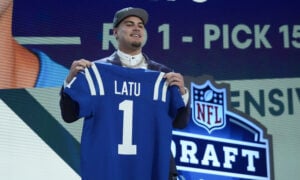Transforming League Format
As a dynasty owner, it’s never too early to start thinking about next year.
With the 2019 fantasy football season in the rear-view mirror, many leagues are looking ahead to the 2020 season. During the off-season, fantasy owners take a look at rule changes, scoring changes, format changes, and league settings, looking to tweak and improve their leagues going forward. Thanks to the multiple dynasty hosting sites out there, you can make an unlimited number of changes each year, but we’ll look at some of the more common alterations leagues go through annually.
To PPR or not to PPR?
While it arguably falls under the category of scoring and not a format, the most common change leagues undergo each off-season is standard-scoring leagues converting to point-per-reception, and I would be remiss not to mention it. Although most people recoil when I say it, I’m still in standard-scoring leagues, and in a world where many owners are in 10+ leagues, the change in scoring helps differentiate leagues from one another. When scrolling through the twitterverse, it looks like more and more people are moving away from standard scoring and adopting PPR as the default option.
Impact on Receivers
Looking at the FantasyPros fantasy point totals for wide receivers between weeks 1-16, you’ll see a few differences between standard scoring on the left and PPR scoring on the right. Truth be told, there wasn’t a massive shake-up at the top of the position pivoting to PPR scoring. Only one player, Redskins’ rookie Terry McLaurin fell out of the top-24 at the position moving from standard to PPR. Touchdown dependent, big-play players were hurt the most, with Kenny Golladay, Mike Evans, Stefon Diggs, and AJ Brown all fell significantly in the rankings. Comparatively, volume heavy receivers who didn’t get in the end zone often saw big bumps when moving to PPR. Julian Edelman, Keenan Allen, DJ Moore, and the volume king- Jarvis Landry were all significantly improved by the move to PPR scoring.

Impact on Running Backs
Much like receivers, overall, the backs didn’t see a big shake-up among the top-24. Of the standard RB1s (left), 11 maintained that ranking when scoring was changed to PPR (right). There was slightly more movement among the RB2s, where nine of the 12 RB2s remained an RB2 in PPR scoring. Most knowledgeable fantasy owners are well aware of the change-of-pace, pass-catching backs, and their increased value in PPR leagues. The Tarik Cohens and Chris Thompsons of the world see a significant bump in PPR compared to standard scoring.

What to Do
If you’re looking to move a standard league to a PPR league and you and your leaguemates aren’t quite sure, I’d suggest dabbling in half-point-PPR to get a feel for it. You won’t see a significant impact on player point totals, but if you’re in an already established league, it also won’t impact player values too much to tip the competitive balance towards a team that may have been stashing volume heavy receivers and backs. Not surprisingly, volume was essential for receivers as 13 of the top 24 moved for or more places in the season end rankings from standard to PPR, while running backs only saw eight of 24 move that much.
Other Scoring Changes
Most of my leagues undergo some form of this every year, especially in IDP leagues. Whether it is intended to balance-out an unforeseen scoring fluke (DB premium gone awry) or to bump up a position that was unintentionally undervalued (hello, DT premium), there are many reasons to tweak your league’s scoring if it helps competitive balance. The change can be something as simple as the PPR changes mentioned above, moving towards TE premium scoring, or moving passing touchdowns from four to six points. As long as a majority of owners support the moves, and it helps the league’s competitive balance and makes your league fun, there is no reason not to kick the tires on scoring changes for a season as a test run. If people don’t like it, you can always change back to whatever you had in place before. A one-year experiment can’t hurt an established dynasty league.
Actual Format Changes
Moving on from scoring changes, which tend to be the most common off-season change, we’ll now take a look at actual format changes that may change the makeup of your entire league.
Adopting IDP
If you’ve never played with individual defensive players (IDP), an excellent way to dip your toes in the water and introduce yourself or your leaguemates to IDP is to start with partial IDP.
I’ve played with one defensive lineman, one linebacker, and one defensive back. Honestly, that probably leaves each position a little too thin and using two at each position, and a defensive flex would probably give you a better intro to IDP.
To balance out the scoring in a shallow IDP league, you can bump up the value of sacks and interceptions too. With only 12-24 new players added to the player pool, you could simply add two rounds or three rounds to your rookie drafts and allow it to include free agent defensive players. It’s a great way to introduce yourself and your leaguemates to IDP action!
Of course, you can go all-in and incorporate full IDP. If you go that route in an established league, you can hold an additional defense-only draft, and who doesn’t love drafting? An entire defensive free agent draft should increase the league-wide interest.
Doubling your roster size and adding a few rounds to your rookie draft are both ways to entice other owners to go down the full IDP path. I’m not a huge IDP guy, but if you’re in multiple dynasty leagues, sprinkling in a few IDP leagues can spice up your interest level if you find your enthusiasm waning.
Full IDP leagues can be a game-changer if everyone in your league gets behind the addition. People may grow to dislike IDP over time, but in my experience, typically, it is greeted with excitement in the early going. Be sure to balance the scoring out though. As you can see below, most standard IDP scoring is heavily geared towards linebackers. If you bump up DT and DE scoring, you can create a ton of draftable value.

Eliminating Positions – Be Gone Kickers and Team DST
The opposite of adding IDP players to your league, some leagues elect to remove the team defense/special teams (DST) and kicker positions from their leagues entirely.
In my longest-running dynasty league, we eliminated team DST after the league’s first year. Despite being in a few dynasty leagues with kickers myself, the #BanKickers movement has gained significant traction over the last few years. The biggest concern when eliminating a position is how to compensate owners for losing a player from their roster.
For example, if you’re in leagues with kickers and you traded away a draft pick or young position player for kicker extraordinaire Justin Tucker last season, it seems unfair to lose him this year without getting anything in return. The same goes for any fantasy team that may have stashed a couple of the leagues’ top defensive units.
The fair thing to do would be to provide owners with compensatory picks. I suggest a league poll to determine what everyone thinks would be adequate compensation. An extra late-round pick would probably be fair for losing a team DST, and maybe an additional middle-round pick if a team had been aggressively pursuing top DST or kickers.
Adding Positions
One of the more popular line-up changes in recent years has been the adoption of superflex leagues, giving teams the option of flexing a second quarterback. If you’ve been in a standard 1-QB league and wanted to move over to superflex, you have a few options at your disposal.
The first (and maybe easiest) option would be to re-pool all of the quarterbacks and hold a two-round quarterback only dispersal draft where all teams would get a chance to draft two quarterbacks. In a 12-team league, 24 signal-callers would be selected, leaving eight starters and multiple backups available on the waiver wire. Draft order could be determined randomly or could be the same order as your rookie draft with the worst teams getting the early picks. I would probably recommend a snake draft no matter which way you’re leaning.
Another option would allow each team to keep one quarterback that is currently on their roster. Outside of the 12 selected “starters,” any back-ups would be thrown into the dispersal pool. You could have a dispersal draft for the remaining quarterbacks only, or allow them to be selected in the incoming rookie draft as well.
There are a lot of different ways to go here, each of which can create some excitement and create more opportunities to add more drafts to your off-season. Pooling the remaining quarterback with all available free agents in an auction would give everyone an equal chance at grabbing QBs 13-24, all of whom are now significantly more value in a superflex league.
Aside from the addition of a superflex position, there are other positional options: adding or eliminating another flex spot, increasing the size of your benches, adding a taxi squad, incorporating devy players into your league, and positional additions.
Adding another starting wide receiver, running back, or tight end spot are all commonly done in the off-season. In a 12-team league, I prefer a 1 QB, 2 RB, 3 WR, 1 TE, 2 flex, nine player starting lineup, with an eight or nine man bench.
Variety is the spice of life, so I like all my leagues to be a little different, and I suspect most fantasy feel the same way. The options are nearly limitless as to how many alterations you can make to your lineups and benches.
Going Forward
Sometimes older dynasty leagues grow stale after a few seasons. Nothing is more defeating to dedicated fantasy owners than to see an established league fall apart due to boredom. Every good league is worth saving, even if you have to rotate in one or two new owners to adopt orphans each year.
Transforming existing leagues to a different format can spike interest among bored owners, and at the very least, stir up a little activity from owners who haven’t contributed much up to that point. Everyone loves drafting, and many of the suggested changes allow your league an opportunity to incorporate an additional draft or two in addition to your rookie draft. If three (or more) off-season drafts can’t stir up excitement in your league, there might be no hope, but a format change is worth a try before folding a league.
- 2024 Off-Season Mock Drafts: Rookie Fallout From an NFL Mock Draft - April 20, 2024
- 2024 Dynasty Fantasy Football Rookie Drafts: A View from the 1.07 - April 17, 2024
- 2024 Off-Season Mock Drafts: Recent Rookie Risers and Fallers - April 13, 2024

































































